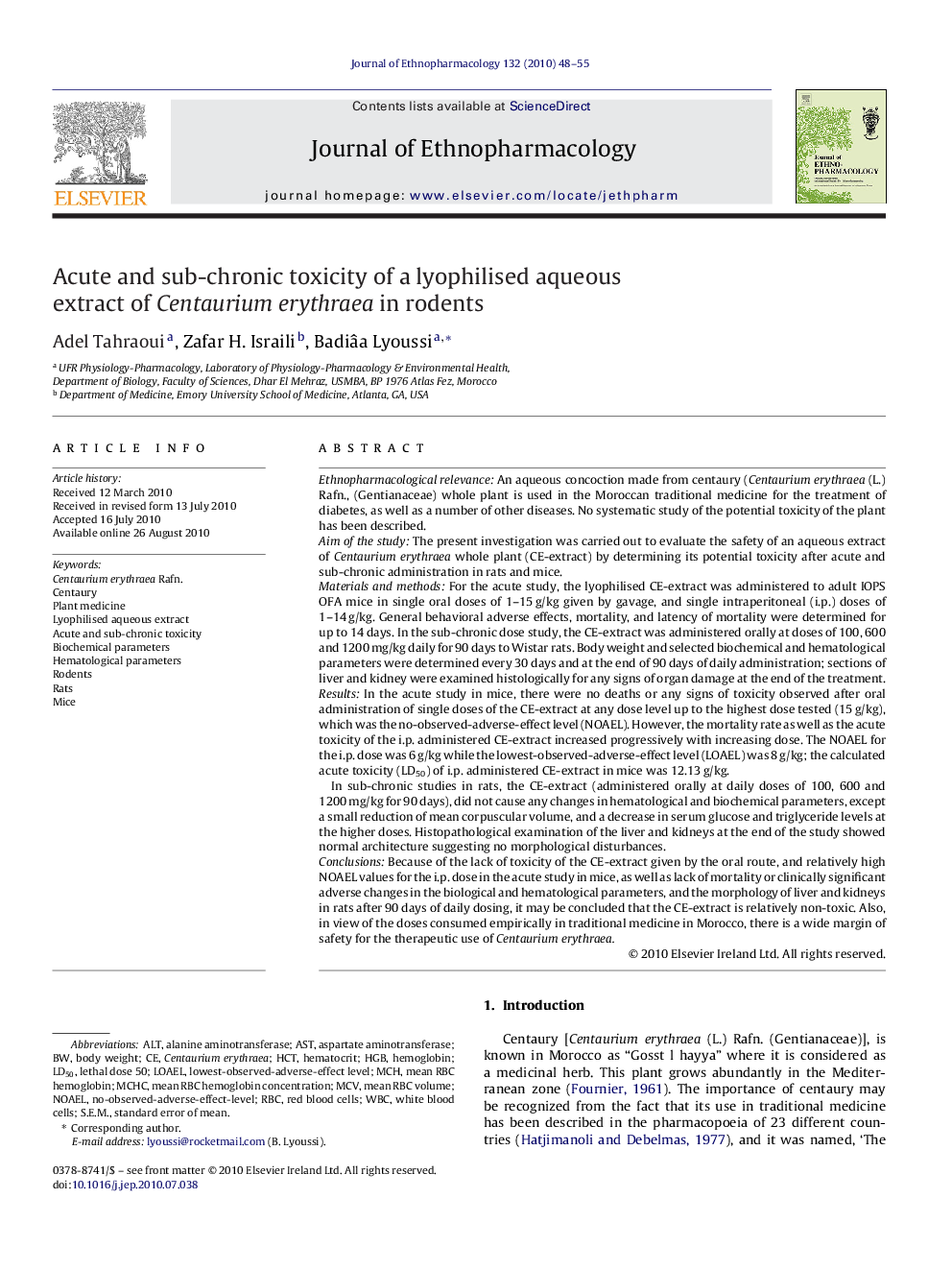| کد مقاله | کد نشریه | سال انتشار | مقاله انگلیسی | نسخه تمام متن |
|---|---|---|---|---|
| 2545647 | 1123990 | 2010 | 8 صفحه PDF | دانلود رایگان |
عنوان انگلیسی مقاله ISI
Acute and sub-chronic toxicity of a lyophilised aqueous extract of Centaurium erythraea in rodents
دانلود مقاله + سفارش ترجمه
دانلود مقاله ISI انگلیسی
رایگان برای ایرانیان
کلمات کلیدی
Acute and sub-chronic toxicityNOAELLOAELMCVMCHCMCHCentaurium erythraeaPlant medicineS.E.M.ALTRBCHCTWBCLD50Red blood cells - سلولهای قرمز خونAST - آسپارتات ترانس آمینازAspartate aminotransferase - آسپارتات ترانس آمیناز یا AST Alanine aminotransferase - آلانین آمینوترانسفرازRodents - جوندگانstandard error of mean - خطای استاندارد میانگینlethal dose 50 - دوز مرگبار 50Lowest-observed-adverse-effect level - سطح پایین ترین مشاهده شده - اثر ناخوشایندMice - موشRats - موش صحراییhematocrit - هماتوکریتHemoglobin - هموگلوبینHgb - هورمون رشدno-observed-adverse-effect-level - هیچ نظارتی و معکوس-اثر-سطحbody weight - وزن بدنBiochemical parameters - پارامترهای بیوشیمیاییHematological parameters - پارامترهای هماتولوژیکwhite blood cells - گلبول های سفید خون
موضوعات مرتبط
علوم پزشکی و سلامت
داروسازی، سم شناسی و علوم دارویی
داروشناسی
پیش نمایش صفحه اول مقاله

چکیده انگلیسی
Ethnopharmacological relevanceAn aqueous concoction made from centaury (Centaurium erythraea (L.) Rafn., (Gentianaceae) whole plant is used in the Moroccan traditional medicine for the treatment of diabetes, as well as a number of other diseases. No systematic study of the potential toxicity of the plant has been described.Aim of the studyThe present investigation was carried out to evaluate the safety of an aqueous extract of Centaurium erythraea whole plant (CE-extract) by determining its potential toxicity after acute and sub-chronic administration in rats and mice.Materials and methodsFor the acute study, the lyophilised CE-extract was administered to adult IOPS OFA mice in single oral doses of 1-15Â g/kg given by gavage, and single intraperitoneal (i.p.) doses of 1-14Â g/kg. General behavioral adverse effects, mortality, and latency of mortality were determined for up to 14 days. In the sub-chronic dose study, the CE-extract was administered orally at doses of 100, 600 and 1200Â mg/kg daily for 90 days to Wistar rats. Body weight and selected biochemical and hematological parameters were determined every 30 days and at the end of 90 days of daily administration; sections of liver and kidney were examined histologically for any signs of organ damage at the end of the treatment.ResultsIn the acute study in mice, there were no deaths or any signs of toxicity observed after oral administration of single doses of the CE-extract at any dose level up to the highest dose tested (15Â g/kg), which was the no-observed-adverse-effect level (NOAEL). However, the mortality rate as well as the acute toxicity of the i.p. administered CE-extract increased progressively with increasing dose. The NOAEL for the i.p. dose was 6Â g/kg while the lowest-observed-adverse-effect level (LOAEL) was 8Â g/kg; the calculated acute toxicity (LD50) of i.p. administered CE-extract in mice was 12.13Â g/kg.In sub-chronic studies in rats, the CE-extract (administered orally at daily doses of 100, 600 and 1200Â mg/kg for 90 days), did not cause any changes in hematological and biochemical parameters, except a small reduction of mean corpuscular volume, and a decrease in serum glucose and triglyceride levels at the higher doses. Histopathological examination of the liver and kidneys at the end of the study showed normal architecture suggesting no morphological disturbances.ConclusionsBecause of the lack of toxicity of the CE-extract given by the oral route, and relatively high NOAEL values for the i.p. dose in the acute study in mice, as well as lack of mortality or clinically significant adverse changes in the biological and hematological parameters, and the morphology of liver and kidneys in rats after 90 days of daily dosing, it may be concluded that the CE-extract is relatively non-toxic. Also, in view of the doses consumed empirically in traditional medicine in Morocco, there is a wide margin of safety for the therapeutic use of Centaurium erythraea.
ناشر
Database: Elsevier - ScienceDirect (ساینس دایرکت)
Journal: Journal of Ethnopharmacology - Volume 132, Issue 1, 28 October 2010, Pages 48-55
Journal: Journal of Ethnopharmacology - Volume 132, Issue 1, 28 October 2010, Pages 48-55
نویسندگان
Adel Tahraoui, Zafar H. Israili, Badiâa Lyoussi,